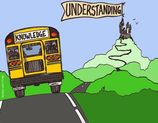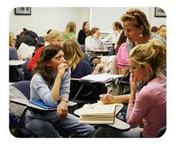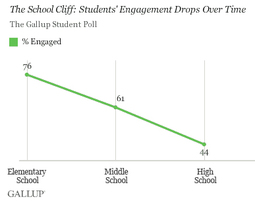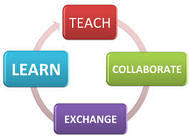Resources to Improve Teaching and Learning
First Things First: Create a Culture of LearningA culture of learning strives for continuous improvement by creating an environment that encourages, challenges and nurtures learners. Excellent teaching is a result of excellent professional learning. It is followed by a commitment to implement best practices in the classroom, and is supported with time, feedback, and resources. In addition, student learning needs are accounted for and addressed through differentiation, meaningful engagement that empowers learners, and the opportunity to practice, apply, and demonstrate understanding. Therefore we might conclude that excellent teaching leads to excellent learning.
A recent blog entry for ASCD Edge written by Steven Weber, a North Carolina Curriculum Leader, identifies the characteristics of a learning culture. He begins by distinguishing between schooling that focuses on teaching and a Culture of Learning that focuses on the whole child and achieving understanding. When we focus on learning before teaching, and understanding rather than just knowledge, we have a better chance of achieving the desired learning goals that stretch the thinking of students. The 17 characteristics Weber identifies connect with the curriculum and instructional discussions that follow on this page. To put this all in perspective, read the full text of Weber's blog here. |
Note: Click on the "full screen" option to view the video.
The 4 C's for College and Career Ready are commonly referred to as "soft skills" because they are not specific content, but yet are skills that are valued in the work force and post secondary education for success. They are:
|
Curriculum

Curriculum is best implemented with a clear plan of action so that the learning goal(s), identified standards, enduring understandings, and essential questions are the focus of the assessments and instructional activities that are planned.
The work of Jay McTighe and Grant Wiggins in their book Understanding by Design, provides educators with a framework for designing and delivering curriculum. It is an appropriate and useful tool for implementing College and Career Ready Standards/Common Core Standards or other rigorous curricula since the focus is on unit planning - which is a recommended course of action for integrating authentic learning.
Click here for an overview of the Understanding by Design Framework
Quick View of UbD Process + Examples
The work of Jay McTighe and Grant Wiggins in their book Understanding by Design, provides educators with a framework for designing and delivering curriculum. It is an appropriate and useful tool for implementing College and Career Ready Standards/Common Core Standards or other rigorous curricula since the focus is on unit planning - which is a recommended course of action for integrating authentic learning.
Click here for an overview of the Understanding by Design Framework
Quick View of UbD Process + Examples
Professional Learning for Curriculum & Instruction
To effectively implement any curriculum educators must:
To that end there is much work to be done with curriculum and instruction through collaborative practices. Click here to learn more about effective professional learning. See below for more information on specific instructional practices that support the implementation of Common Core.
- Provide quality professional learning that includes learning about the standards and what they are asking of teachers and students; practice opportunities, and collaborative dialogue to fine tune instruction during implementation.
- Examine effective instructional strategies and active learning experiences that deepen thinking, provide opportunities for application, and include 21st Century skills.
- Provide support for educators during the implementation process with feedback, resources, collaborative opportunities, and time.
- Include more cross curricular application and authentic learning/assessment in instruction.
To that end there is much work to be done with curriculum and instruction through collaborative practices. Click here to learn more about effective professional learning. See below for more information on specific instructional practices that support the implementation of Common Core.
Instruction

Teacher effectiveness is the most important factor affecting student learning according to the work of Robert J. Marzano and associates (as noted on p. 3 in Classroom Instruction That Works, 2001). Because of the great influence that teaching has on learning, improving instruction is the foundation to all school improvement efforts.
Marzano and associates identified 9 instructional strategies as High Yield Strategies because they have the most impact on learning. Identifying similarities and differences and summarizing and note taking are the top 2 strategies and should be the primary focus of our instruction, yet we often assume students can do these without any intentional planning on our part. These 9 strategies were intended to increase learning, and not used as teaching strategies alone. Many schools have misused these High Yield Strategies to target instruction rather than learning. Click here for more information.
Charlotte Danielson has done great deal of work in the realm of what quality teaching looks like. Her work is the basis for many evaluation tools and reflects many of the instructional strategies identified by Marzano and his associates. Click on this link to look at Danielson's Framework for Teaching.
Differentiated Instruction is a philosophy, not a program or quick fix. It addresses the many learning needs, readiness levels, and interests that students bring to the classroom. Using assessments before, during and after learning, teachers can determine needs and adjust instruction to provide relevant learning opportunities. Differentiation provides multiple paths and can be achieved through content, process, product, and/or environment. Carol Ann Thompson is the author of many books on this subject and has been a leading advocate for changing instruction to meet the needs of the learner. This concept works hand in hand with Marzano's work, by increasing student engagement and understanding. Click here for Thompson's insight into Differentiated Instruction.
Myth Busting DI: Why we CAN (and should) differentiate our instruction despite our concerns. Edutopia blogger John McCarthy uncovers 3 Myths and 3 Truths about Differentiated instruction. As a follow up to this, McCarthy writes in a recent article, There's No Time to Differentiate: Myth Busting, points out the ways we can overcome our resistance (excuses) for why we don't differentiate: Too many kids; too much to cover; no time. Click here to read more.
Marzano and associates identified 9 instructional strategies as High Yield Strategies because they have the most impact on learning. Identifying similarities and differences and summarizing and note taking are the top 2 strategies and should be the primary focus of our instruction, yet we often assume students can do these without any intentional planning on our part. These 9 strategies were intended to increase learning, and not used as teaching strategies alone. Many schools have misused these High Yield Strategies to target instruction rather than learning. Click here for more information.
Charlotte Danielson has done great deal of work in the realm of what quality teaching looks like. Her work is the basis for many evaluation tools and reflects many of the instructional strategies identified by Marzano and his associates. Click on this link to look at Danielson's Framework for Teaching.
Differentiated Instruction is a philosophy, not a program or quick fix. It addresses the many learning needs, readiness levels, and interests that students bring to the classroom. Using assessments before, during and after learning, teachers can determine needs and adjust instruction to provide relevant learning opportunities. Differentiation provides multiple paths and can be achieved through content, process, product, and/or environment. Carol Ann Thompson is the author of many books on this subject and has been a leading advocate for changing instruction to meet the needs of the learner. This concept works hand in hand with Marzano's work, by increasing student engagement and understanding. Click here for Thompson's insight into Differentiated Instruction.
Myth Busting DI: Why we CAN (and should) differentiate our instruction despite our concerns. Edutopia blogger John McCarthy uncovers 3 Myths and 3 Truths about Differentiated instruction. As a follow up to this, McCarthy writes in a recent article, There's No Time to Differentiate: Myth Busting, points out the ways we can overcome our resistance (excuses) for why we don't differentiate: Too many kids; too much to cover; no time. Click here to read more.
Engagement: Active and Connected Learning that Empowers Students

Active Engagement: The secret to increased interest; higher levels of thinking; deeper inquiry; that lead to improved student behavior and deeper understanding.
What constitutes "engagement" as it applies to learning?
Engaged, Effective Learners
Have you ever noticed that kids who are busy don't get in trouble as often as kids who have idle hands? Learning that involves movement, sensory experiences, and authentic activities connect us to the content and are what we tend to remember most. Why is it that as students get older and are more ABLE to sit still, we let them?
Think about the high energy levels and active learning strategies that are observed in primary grades. Walk up the hallway toward the upper grade levels and see how many students are sitting in their desks.... alone? Which looks like a place you'd like to learn and work? Where are the conversations happening? Where are the ideas being shared?
Think about the work place where an assembly line or 6 foot cubicle walls separate (and isolate) workers compared to the areas where those same workers congregate for breaks and lunch? Where are the conversations happening? Where are the ideas being shared? The work place is transforming and so must schools.
The School Cliff: Student Engagement Drops With Each Year of School - This blog by the Gallup Poll folks shares what we know is happening in our schools but may not realize it because "it's just the way it's always been." (see graph at the beginning of the section)
Many questions come to mind when considering the results of this study. What is this level of disengagement doing to our students? How are we preparing them for the critical thinking and creativity our society needs to keep our economy going as we improve what is already present and invent those new products we will soon be unable to live without?
Engagement involves inquiry, thinking, collaboration, hands-on (but with minds-on too!), and application that leads to transfer. What good is it to know something if we don't know how and when to use it? Engaged learners are problem solvers, are eager to make new connections, and see what they can do with this new learning. They are "hooked" on the subject matter because it's interesting and they see relevance to this new learning.
Integrating the 16 Habits of Mind. Habits of Mind were identified by Art Costa and Bena Kallick as problem solving and life skills to promote reasoning and equip the individual to work through real life situations. This has caused us to think about how people learn and how educators might integrate and cultivate these habits to produce more engaged and effective learners. Blogger Terry Heick explores ways to utilize the 16 habits to strengthen the 21st Century learning environment.
Asking good questions is an engaging strategy of its own. Good questions promote higher level thinking and trigger additional questions (inquiry). Essential Questions are a key component of the curriculum framework, Understanding by Design (see additional information on this page about UbD). "Essential Questions promote understanding, spark connections and promote transfer." (Wiggins & McTighe, 2005) A 2011 article from the Capacity Building Series by Ontario, Canada Schools, Asking Effective Questions, seeks to provoke student thinking and deepen the conceptual understanding in the math classroom, but most all of the ideas put forth in this article would be useful to any content area teacher.
The challenge facing educators today isn't competing with a fast paced technological world, but to create meaning and investment on the part of the learner in the task at hand. That is engagement in the most meaningful form and the kind of learning that is more permanent and useful in the future than merely memorizing and learning intravenously!
Gaming Strategies. One way to motivate and engage learners is to integrate meaningful technology through the use of gaming strategies. This also has the added benefit of teaching participants how to use problem solving strategies, create, collaborate, and set and achieve goals. University of Pennsylvania Associate Professor Kevin Werbach, notes:
"Game design techniques can activate our innate desires to recognize patterns, solve puzzles, master challenges, collaborate with others, and be in the drivers’ seat when experiencing the world around us. They can also create a safe space for experimentation and learning. After all, why not try something new when you know that even if you fail, you’ll get another life?"
Read more of Werbach's March 2015 blog: Gamification Harnesses the Power of Games to Motivate
*****************
"You know after reading the first few pages of a book if you will continue.
Students know in the first few minutes of class if they will stay engaged."
- Kami Thordarson
via ASCD Education Update
What constitutes "engagement" as it applies to learning?
Engaged, Effective Learners
Have you ever noticed that kids who are busy don't get in trouble as often as kids who have idle hands? Learning that involves movement, sensory experiences, and authentic activities connect us to the content and are what we tend to remember most. Why is it that as students get older and are more ABLE to sit still, we let them?
Think about the high energy levels and active learning strategies that are observed in primary grades. Walk up the hallway toward the upper grade levels and see how many students are sitting in their desks.... alone? Which looks like a place you'd like to learn and work? Where are the conversations happening? Where are the ideas being shared?
Think about the work place where an assembly line or 6 foot cubicle walls separate (and isolate) workers compared to the areas where those same workers congregate for breaks and lunch? Where are the conversations happening? Where are the ideas being shared? The work place is transforming and so must schools.
The School Cliff: Student Engagement Drops With Each Year of School - This blog by the Gallup Poll folks shares what we know is happening in our schools but may not realize it because "it's just the way it's always been." (see graph at the beginning of the section)
Many questions come to mind when considering the results of this study. What is this level of disengagement doing to our students? How are we preparing them for the critical thinking and creativity our society needs to keep our economy going as we improve what is already present and invent those new products we will soon be unable to live without?
Engagement involves inquiry, thinking, collaboration, hands-on (but with minds-on too!), and application that leads to transfer. What good is it to know something if we don't know how and when to use it? Engaged learners are problem solvers, are eager to make new connections, and see what they can do with this new learning. They are "hooked" on the subject matter because it's interesting and they see relevance to this new learning.
Integrating the 16 Habits of Mind. Habits of Mind were identified by Art Costa and Bena Kallick as problem solving and life skills to promote reasoning and equip the individual to work through real life situations. This has caused us to think about how people learn and how educators might integrate and cultivate these habits to produce more engaged and effective learners. Blogger Terry Heick explores ways to utilize the 16 habits to strengthen the 21st Century learning environment.
Asking good questions is an engaging strategy of its own. Good questions promote higher level thinking and trigger additional questions (inquiry). Essential Questions are a key component of the curriculum framework, Understanding by Design (see additional information on this page about UbD). "Essential Questions promote understanding, spark connections and promote transfer." (Wiggins & McTighe, 2005) A 2011 article from the Capacity Building Series by Ontario, Canada Schools, Asking Effective Questions, seeks to provoke student thinking and deepen the conceptual understanding in the math classroom, but most all of the ideas put forth in this article would be useful to any content area teacher.
The challenge facing educators today isn't competing with a fast paced technological world, but to create meaning and investment on the part of the learner in the task at hand. That is engagement in the most meaningful form and the kind of learning that is more permanent and useful in the future than merely memorizing and learning intravenously!
Gaming Strategies. One way to motivate and engage learners is to integrate meaningful technology through the use of gaming strategies. This also has the added benefit of teaching participants how to use problem solving strategies, create, collaborate, and set and achieve goals. University of Pennsylvania Associate Professor Kevin Werbach, notes:
"Game design techniques can activate our innate desires to recognize patterns, solve puzzles, master challenges, collaborate with others, and be in the drivers’ seat when experiencing the world around us. They can also create a safe space for experimentation and learning. After all, why not try something new when you know that even if you fail, you’ll get another life?"
Read more of Werbach's March 2015 blog: Gamification Harnesses the Power of Games to Motivate
*****************
"You know after reading the first few pages of a book if you will continue.
Students know in the first few minutes of class if they will stay engaged."
- Kami Thordarson
via ASCD Education Update
Additional Information:
For information and ideas on Classroom Management click here.
Connect to Vicki's Wiki for additional resources in the areas of Differentiated Instruction, Common Core, Poverty, Improving Teaching and Learning, and Professional Learning Communities.
Connect to Vicki's Wiki for additional resources in the areas of Differentiated Instruction, Common Core, Poverty, Improving Teaching and Learning, and Professional Learning Communities.
*Teaching and Learning Consulting Network, LLC does not endorse or determine reliability of claims of effectiveness or alignment. Information is intended only for reader consideration.

The Teaching and Learning Consulting Network, LLC:
Supporting the quest to improve teaching and learning
